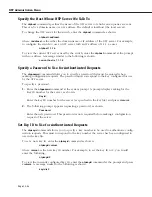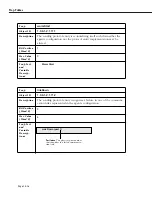
Configuring SNMP Parameters and Traps
Page 13-4
6) Broadcast Traps
When broadcast traps are enabled, the switch transmits traps to all NMS stations in the default
group. If you enable this parameter, unicast traps (see option 6 below) will automatically be
disabled. The default for broadcast traps is
disabled
. To enable broadcast traps, enter the
following command:
5=enabled
The following prompt displays:
UDP destination port (162):
Enter the
UDP
destination port for the traps.
UDP
port 162 is the default port and is commonly
used for traps; however, the destination port can be re-defined to accommodate a network
management station using a nonstandard port.
♦
Note
♦
The destination port configured here must corre-
spond to the
UDP
destination port configured at the
receiving network management station(s).
7) Unicast Traps
When unicast traps are enabled, the switch transmits traps only to the
IP
address(es) defined
in the
snmpc
list below this field.
♦
Note
♦
If both broadcast and unicast traps are disabled, then
the switch does not transmit any traps.
If you enable this parameter, broadcast traps (see option 5 above) will automatically be
disabled. The default for unicast traps is disabled. To enable unicast traps, enter the follow-
ing command:
6=enabled
Configuring a New Network Management Station
a.
To define a new network management station, enter 8, followed by an equal sign (
=
), and
the
IP
address of the network management station to receive traps. You can define a maxi-
mum of ten network management stations. They must be numbered sequentially from 8
through 17. If network management stations are already shown on the display for this
menu, use the next highest number to add another station. The following is an example of
how to define the first network management station:
8=123.12.1.1
The following prompt displays:
Enter trap mask words 0:1 (ffffffff:ffffffff):
Each trap in the switch is assigned a mask that consists of “words”. The mask value
ffffffff:ffffffff
indicates that
all
traps are enabled for words 0 and 1. If you want to accept
this default (all traps enabled for words 0 and 1), press <
Enter
>. If you want to enable
one or more specific traps for words 0 and 1, you must calculate their bit configurations
and enter the new mask value at the prompt. Trap types and their bit positions are listed
in the tables beginning on page 13-11.
Summary of Contents for Omni Switch/Router
Page 1: ...Part No 060166 10 Rev C March 2005 Omni Switch Router User Manual Release 4 5 www alcatel com ...
Page 4: ...page iv ...
Page 110: ...WAN Modules Page 3 40 ...
Page 156: ...UI Table Filtering Using Search and Filter Commands Page 4 46 ...
Page 164: ...Using ZMODEM Page 5 8 ...
Page 186: ...Displaying and Setting the Swap State Page 6 22 ...
Page 202: ...Creating a New File System Page 7 16 ...
Page 270: ...Displaying Secure Access Entries in the MPM Log Page 10 14 ...
Page 430: ...OmniChannel Page 15 16 ...
Page 496: ...Configuring Source Route to Transparent Bridging Page 17 48 ...
Page 542: ...Dissimilar LAN Switching Capabilities Page 18 46 ...
Page 646: ...Application Example DHCP Policies Page 20 30 ...
Page 660: ...GMAP Page 21 14 ...
Page 710: ...Viewing the Virtual Interface of Multicast VLANs Page 23 16 ...
Page 722: ...Application Example 5 Page 24 12 ...
Page 788: ...Viewing UDP Relay Statistics Page 26 24 ...
Page 872: ...The WAN Port Software Menu Page 28 46 ...
Page 960: ...Deleting a PPP Entity Page 30 22 ...
Page 978: ...Displaying Link Status Page 31 18 ...
Page 988: ...Displaying ISDN Configuration Entry Status Page 32 10 ...
Page 1024: ...Backup Services Commands Page 34 14 ...
Page 1062: ...Diagnostic Test Cable Schematics Page 36 24 ...
Page 1072: ...Configuring a Switch with an MPX Page A 10 ...
Page 1086: ...Page B 14 ...
Page 1100: ...Page I 14 Index ...






























